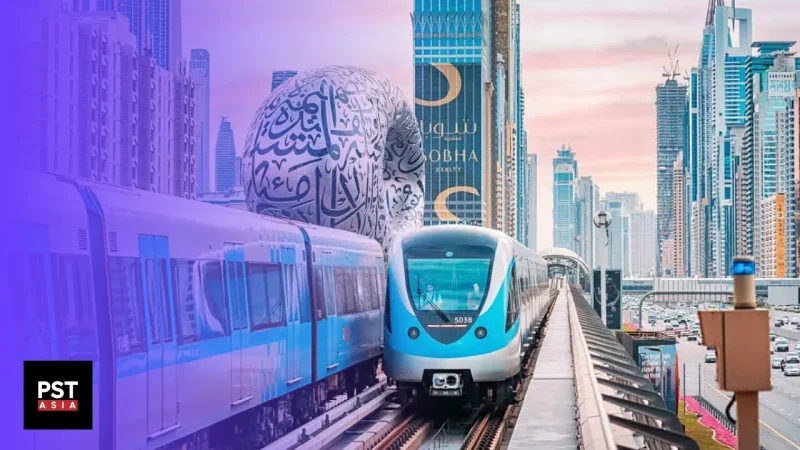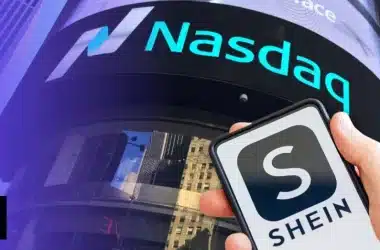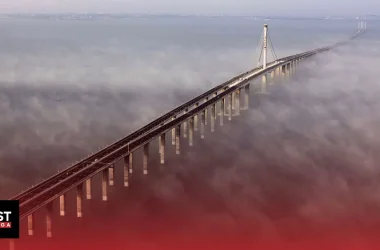In line with Dubai’s many infrastructure investments to accommodate its citizens and visitors, Dubai’s ruler, Sheikh Mohammed bin Rashid, just announced the approval of the construction of a brand new metro line, called the Blue Line.
This extension to Dubai’s metro will serve several communities, including Mirdif, International City, Dubai Creek, Al Warqa, and Silicon Oasis, among many others.
The mega project is set to open in 2029 and will cost a massive $4.9 billion.
We’re going to explore every aspect of the new project, and compare its benefits to its huge cost to see if it’s really worth it.
The Dubai Metro Blue Line
The UAE’s vice president and Dubai’s ruler, Sheikh Mohammed bin Rashid, announced that plans for the construction of the new Dubai Metro Blue Line have been approved.
This project will be the largest and most expensive project in the country’s public transportation sector, with a total cost of Dh18 billion or $4.9 billion.
The vibrant city of Dubai will get a brand new 30-kilometer extension, of which 15.5 kilometers are underground, to its already existing metro system. It is set to transform the north-east of the city by reducing traffic and easing congestion.
Additionally, it will contribute to enhancing global connectivity by establishing a direct link with Dubai International Airport.
The Blue Line will include 14 new stations, of which seven will be elevated, and five will be underground stations, and we’ll go over them in detail.
The new Metro Blue Line will include two main routes that start with connections with the existing Red and Green Lines. The first route begins in Al Jaddaf, a city famous for its ships and docking yards, at the Creek Interchange Station on the Green Line, and will cross Dubai Creek on a 1.3 kilometers long bridge.
This route will pass through new stations that will be established at Dubai Festival City, Dubai Creek Harbour, and Ras Al Khor, before arriving at Dubai International City 1, which is another interchange station.
Then, the line will continue towards Dubai International City 2 and 3 and on to Dubai Silicon Oasis, with the route ending at Academic City. This part of the line is expected to span 21 kilometers and feature ten stations.
Moving on to the second route, which connects with another already existing line, the Red Line, in Al Rashidiya, an upscale residential area at the Centrepoint interchange station.
It will pass through new stations at Mirdif and Al Warqaa, before connecting with the interchange station at Dubai International City 1. This section will be 9 kilometers long, and include four stations.
The Two Unique Stations
Even though most of the new stations will have the same design as the current metro routes, the Blue Line will house two noteworthy stations.
According to Dubai’s Road and Transport Authority, the Dubai Creek Harbour stop would have an “iconic station” with a “distinctive architectural design” that will complement the surrounding modern residential and commercial towers.
The station will be designed by the same firm that designed the Burj Khalifa, the Willis Tower in Chicago, and the Denver Union Station in Colorado: the global architectural firm Skidmore, Owings, and Merrill.
The other special station will be the underground station at International City, which will span 44,000 square meters, making it the largest underground interchange station in the entire metro network.
Benefits And Environmentally Friendly Construction
In addition to its impressive designs, the new metro line is expected to save a lot of time for commuters, since the travel time between the destinations will be from 10 to 25 minutes. Also, it plans to accommodate about 350,000 passengers on a daily basis.
Additionally, the project isn’t just a new metro line; it also includes the construction of a new metro depot to maintain the trains at Al Ruwayyah 3, beyond Academic City.
Like many other new Emirati infrastructure projects, this one won’t compensate for environmentally friendly and sustainable construction, as it will be built in compatibility with Green Buildings specifications in accordance with LEED (Leadership in Energy and Environmental Design, the most widely used green building rating system), with special care put into achieving the requirements needed for the highest Platinum category.
The project is expected to be completed in 2029, the same year as the 20th anniversary of the Dubai Metro. Construction is expected to start with the tunneling for the underground sections of the routes and stations in 2025, and the first trials are expected to take place in 2028.
When completed, the Dubai metro network will be 131 kilometers long and include 78 stations served by 168 trains.
The bidding for the project has already started, and winning contractors are expected to be awarded the contracts sometime next year.
Why Dubai Needs It
The decision to expand the city’s metro network was taken with the Dubai 2040 Urban Master Plan in mind, which was launched two years ago in March.
It maps out a comprehensive plan for sustainable urban development in Dubai, with the key objectives of upgrading the city’s urban areas, improving the efficiency of resource utilization, providing a healthy environment to residents and visitors, and providing sustainable and flexible means of mobility.
In addition to that, the plan recognized the need for better and expanded commuting to cater for a fast-growing population.
The UAE’s population is around 10.17 million people, of which 88.52% are expats and 11.48% are Emirati. Along with that, 3.64 million people of the population live in Dubai.
Because of the country’s expat-friendly laws and diverse, multicultural position, foreign workers make up most of the population there, a trend that is likely to remain the same in the future.
That is why there’s a need for more transportation methods since many people in the population are workers, and more than 700,000 people commute to Dubai every day from other emirates.
Aside from accommodating citizens and expats, the new metro line will have several other benefits.
First of all, the project will help reduce traffic in Dubai. According to the Road and Transport Authority, traffic congestion on the new line’s routes will be reduced by 20%.
Additionally, the project will boost real estate prices and values of the properties and land near the new stations by up to 25%.
The Blue Line is estimated to be able to serve 200,000 passengers a day by 2030, with that number increasing to 320,000 10 years later in 2040. It will also make commuting easier for university students, of which 50,000 from the Academic City are expected to make use of the line when it opens.
Finally, it is designed to handle a capacity of around 56,000 passengers an hour in both directions, at a service interval of about 1.5 minutes.
Benefits vs. Costs
The project is expected to yield a benefit-cost ratio, which is an indicator that shows the relationship between the costs and benefits of a proposed project, of 2.60 by 2040.
To put it in simpler terms, the project will offer benefits worth Dh2.60 for every Dh1 spent, and by 2040, total expected benefits will exceed Dh56.5 billion, which is a number that is approximately 214% higher than the original cost of the project.
The new Blue Line also represents a significant achievement for Dubai and the UAE as a whole, since it’s the first-ever metro route crossing the Dubai Creek through a 1300-meter-long bridge.
A Lifeline
To date, Dubai’s metro has been used over 2 billion times. It is not just a method of transportation, but a lifeline that connects the bustling global hub.
In order to add to and continue this legacy, construction on the Blue Line was approved. It is Sheikh Mohammed bin Rashid’s vision that the new metro extension will help to serve billions more in the decades to come.
This project is a perfect example of projects under the Dubai 2040 Urban Plan, and as Dubai’s daytime population is set to increase to 7.8 million in 2040, the necessity of a “comprehensive plan for sustainable urban development” in the city is very clearly demonstrated.
While the project’s costs are high, its benefits far outweigh them. The Blue Line will offer Dubai a lot of social, economic, and environmental benefits, since it is set to meet the rapid economic and urban growth in the city.
It will establish many links between the main economic and social hubs in Dubai. Still, it will also connect directly to the city’s international airport, establishing an important global link for the country, which is nearly 90% foreigners.
This monumental project shows the UAE’s dedication and commitment to innovation, connectivity, and sustainable development. It’s certain, and not surprising that many people who live in Dubai are eagerly waiting for this metro line’s opening day.
Disclaimer
Please visit and read our disclaimer here.









